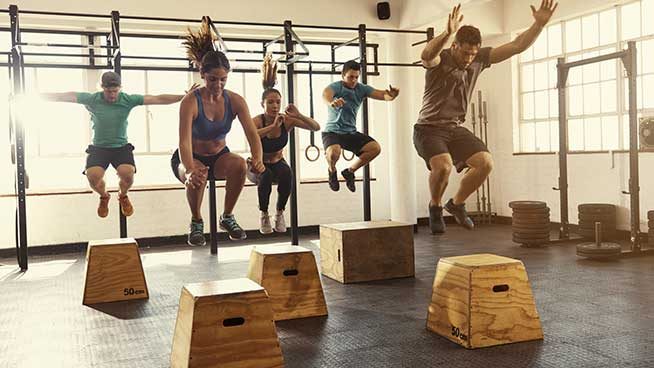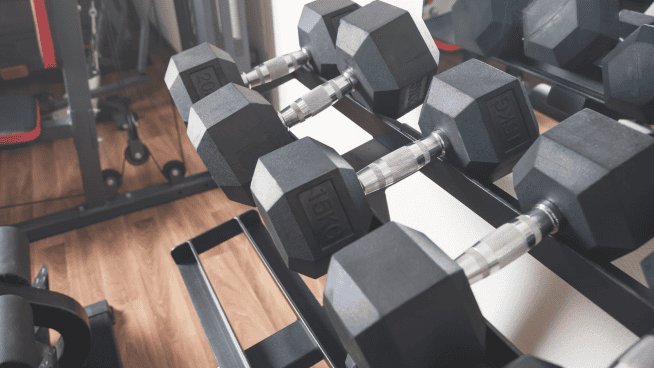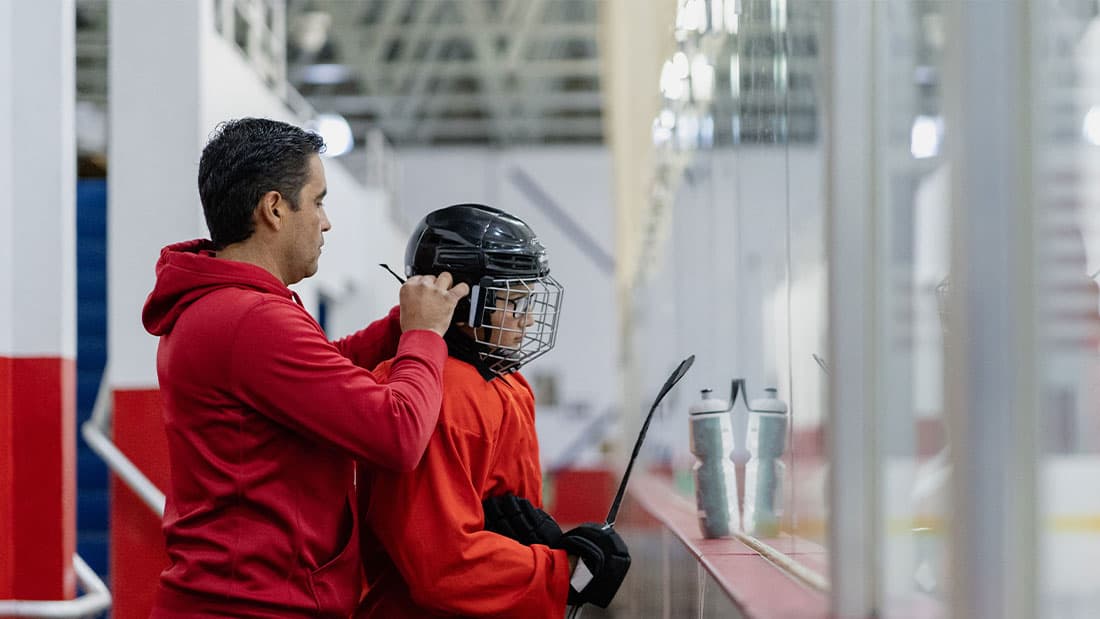4 Vertical Jump Training Mistakes
Sports are decided by a split second or a couple inches, and what separates elite athletes from the rest of the pack is their explosiveness. Explosiveness is basically another term for power and one of the best ways train for power is through vertical jump training.
The Vertical Jump is used in weight rooms all over to assess an athlete’s explosive power. Typically, a superior Vertical Jump correlates well in other performance indicators such as leg strength and sprinting speed.
And if you’ve ever played basketball or were a receiver in football you know an extra inch or two can make the difference when trying to secure a rebound or catch a pass.
But are you applying jump training correctly? What mistakes could be holding back your performance? Here are four mistakes to avoid in your vertical jump training.
Bypassing Landing Technique
Probably the most overlooked (and possibly most important) aspect of jump training is proper landing technique.
I get it. It is much more exciting to see how high you can jump than to focus on how you land from that jump. Basically, quality over quantity tends to win in this social media age.
Learning proper landing technique is essential for decreasing your likelihood of injury. Learning proper landing technique is learning how to absorb high forces correctly. You must learn to absorb force before you can create it. Failure to learn how to land correctly can lead to overuse injuries or even the dreaded ACL injury.
Teaching landing technique is especially important in the jump training of women. Due to their physical structure and other factors, teaching proper landing technique can have a huge effect on injury prevention in female athletes.
So what is proper landing technique?
Here are some cues to remember when learning the proper landing technique
- Land on toes first and transfer weight through your foot
- Knees over second toes. This cue helps to limit knee valgus (inward collapse) by controlling pronation, or letting your feel roll inward.
- Don’t land stiff-legged. Allow the muscles of your lower body to absorb the force and you bend at the knees and hips.
- Sit Back. This will cue you to load the posterior chain and absorb the forces of the landing. Landing with your center of gravity more forward can put immense stress on the anterior knee.
Snapdowns are one of my favorite drills to help reinforce proper landing technique. It is often used as a way to teach proper take off mechanics during vertical jump training but is also a great way to initiate teaching landing positions.
[youtube video=”rR4YRR577Q4″ /]Not Utilizing Maximal Intent
When training to jump higher, it is important to perform each rep with maximal intent. This will help ensure that maximal force is created by the athlete. If maximal intent is not utilized, then results or adaptations seen while not be optimal.
Feedback can be really effective for ensuring that the athlete is completing the exercise with maximal intent. Velocity monitoring systems can be an effective tool to ensure intent is maximal. It also adds a competitive aspect as the athlete tries to move it faster each time. This visual feedback can have huge effect on motivation throughout the workout
Too Much Volume
Maximal velocity with each rep is the goal with power training but velocity is very susceptible to fatigue. As fatigue begins to set in, achieving maximal velocity can become very difficult.
As repetitions begin to creep up through the workout, the ability to recover becomes much harder. High volumes can lead to submaximal efforts, leading to a less than optimal training session.
Total workout volume and intraset volume can lead to a less than optimal vertical jump training session.
For example, I love the Vertimax and think it is a great tool but it is often used in a less than optimal manner. Often I will see videos of athletes completing high reps of jumps on the Vertimax. At about rep 5 the athlete begins to “grind” through reps, barely jumping off the platform.
Is the athlete getting optimal jump training by adding more reps in the set or would they have been better off cutting the set off at rep 3 or 4 when they were still getting good quality reps? In training for power production, quality over quantity is the goal. Cutting the set off at rep 3 will lead to greater progress in power production.
Want to train to be fast you must train fast and fatigue can effect your ability to train power optimally. Keep your reps low and your intensity high.
Neglecting Strength
Let’s first look at the equation for power before we move forward.
Power=Force x velocity
Now that we know what makes up power let’s break down the components of this equation. First, strength is one’s ability to produce force. Add an aspect of velocity or how fast you can move against resistance, whether against gravity or an outside load, and you have power.
A higher force ceiling, or greater max strength, allows for greater force production. If your force ceiling is low, your ability to create force decreases greatly.
This is where some people go wrong in their vertical jump training. They only focus on the velocity aspect of the equation. They neglect their ability to produce force and only focus on moving fast. This may have some positive effects but eventually they will reach their power potential much faster than their stronger counterpart.
If you want to reach your true potential in your vertical jump training, you must focus on both strength and speed. Neglect one and your ability to produce force will be effected.
READ MORE:
[cf]skyword_tracking_tag[/cf]RECOMMENDED FOR YOU
MOST POPULAR
4 Vertical Jump Training Mistakes
Sports are decided by a split second or a couple inches, and what separates elite athletes from the rest of the pack is their explosiveness. Explosiveness is basically another term for power and one of the best ways train for power is through vertical jump training.
The Vertical Jump is used in weight rooms all over to assess an athlete’s explosive power. Typically, a superior Vertical Jump correlates well in other performance indicators such as leg strength and sprinting speed.
And if you’ve ever played basketball or were a receiver in football you know an extra inch or two can make the difference when trying to secure a rebound or catch a pass.
But are you applying jump training correctly? What mistakes could be holding back your performance? Here are four mistakes to avoid in your vertical jump training.
Bypassing Landing Technique
Probably the most overlooked (and possibly most important) aspect of jump training is proper landing technique.
I get it. It is much more exciting to see how high you can jump than to focus on how you land from that jump. Basically, quality over quantity tends to win in this social media age.
Learning proper landing technique is essential for decreasing your likelihood of injury. Learning proper landing technique is learning how to absorb high forces correctly. You must learn to absorb force before you can create it. Failure to learn how to land correctly can lead to overuse injuries or even the dreaded ACL injury.
Teaching landing technique is especially important in the jump training of women. Due to their physical structure and other factors, teaching proper landing technique can have a huge effect on injury prevention in female athletes.
So what is proper landing technique?
Here are some cues to remember when learning the proper landing technique
- Land on toes first and transfer weight through your foot
- Knees over second toes. This cue helps to limit knee valgus (inward collapse) by controlling pronation, or letting your feel roll inward.
- Don’t land stiff-legged. Allow the muscles of your lower body to absorb the force and you bend at the knees and hips.
- Sit Back. This will cue you to load the posterior chain and absorb the forces of the landing. Landing with your center of gravity more forward can put immense stress on the anterior knee.
Snapdowns are one of my favorite drills to help reinforce proper landing technique. It is often used as a way to teach proper take off mechanics during vertical jump training but is also a great way to initiate teaching landing positions.
Not Utilizing Maximal Intent
When training to jump higher, it is important to perform each rep with maximal intent. This will help ensure that maximal force is created by the athlete. If maximal intent is not utilized, then results or adaptations seen while not be optimal.
Feedback can be really effective for ensuring that the athlete is completing the exercise with maximal intent. Velocity monitoring systems can be an effective tool to ensure intent is maximal. It also adds a competitive aspect as the athlete tries to move it faster each time. This visual feedback can have huge effect on motivation throughout the workout
Too Much Volume
Maximal velocity with each rep is the goal with power training but velocity is very susceptible to fatigue. As fatigue begins to set in, achieving maximal velocity can become very difficult.
As repetitions begin to creep up through the workout, the ability to recover becomes much harder. High volumes can lead to submaximal efforts, leading to a less than optimal training session.
Total workout volume and intraset volume can lead to a less than optimal vertical jump training session.
For example, I love the Vertimax and think it is a great tool but it is often used in a less than optimal manner. Often I will see videos of athletes completing high reps of jumps on the Vertimax. At about rep 5 the athlete begins to “grind” through reps, barely jumping off the platform.
Is the athlete getting optimal jump training by adding more reps in the set or would they have been better off cutting the set off at rep 3 or 4 when they were still getting good quality reps? In training for power production, quality over quantity is the goal. Cutting the set off at rep 3 will lead to greater progress in power production.
Want to train to be fast you must train fast and fatigue can effect your ability to train power optimally. Keep your reps low and your intensity high.
Neglecting Strength
Let’s first look at the equation for power before we move forward.
Power=Force x velocity
Now that we know what makes up power let’s break down the components of this equation. First, strength is one’s ability to produce force. Add an aspect of velocity or how fast you can move against resistance, whether against gravity or an outside load, and you have power.
A higher force ceiling, or greater max strength, allows for greater force production. If your force ceiling is low, your ability to create force decreases greatly.
This is where some people go wrong in their vertical jump training. They only focus on the velocity aspect of the equation. They neglect their ability to produce force and only focus on moving fast. This may have some positive effects but eventually they will reach their power potential much faster than their stronger counterpart.
If you want to reach your true potential in your vertical jump training, you must focus on both strength and speed. Neglect one and your ability to produce force will be effected.
READ MORE:
[cf]skyword_tracking_tag[/cf]











